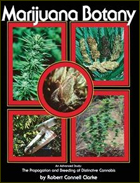
by Robert Connell Clarke
Biology of Pollination
Pollination is the event of pollen landing on a stigmatic surface such as the pistil, and fertilization is the union of the staminate chromosomes from the pollen with the pistillate chromosomes from the ovule. Pollination begins with dehiscence (release of pollen) from staminate flowers. Millions of pollen grains float through the air on light breezes, and many land on the stigmatic surfaces of nearby pistillate plants. If the pistil is ripe, the pollen grain will germinate and send out a long pollen tube much as a seed pushes out a root. The tube contains a haploid (in) generative nucleus and grows downward toward the ovule at the base of the pistils. When the pollen tube reaches the ovule, the staminate haploid nucleus fuses with the pistillate haploid nucleus and the diploid condition is restored.
Germination of the pollen grain occurs 15 to 20 minutes after contact with the stigmatic surface (pistil); fertilization may take up to two days in cooler temperatures. Soon after fertilization, the pistils wither away as the ovule and surrounding calyx begin to swell. If the plant is properly watered, seed will form and sexual reproduction is complete. It is crucial that no part of the cycle be interrupted or viable seed will not form. If the pollen is subjected to extremes of temperature, humidity, or moisture, it will fail to germinate, the pollen tube will die prior to fertilization, or the embryo will be unable to develop into a mature seed. Techniques for successful pollination have been designed with all these criteria in mind.

